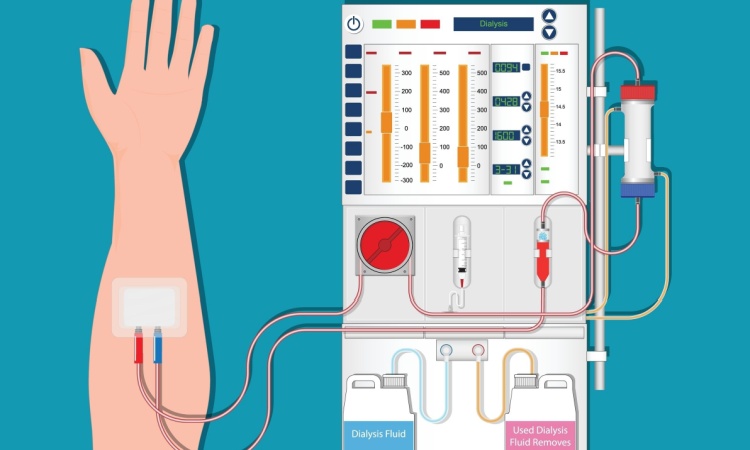Types of Dialysis and How They Work Explained
Types of Dialysis and How They Work Explained

What happens when your kidneys can no longer do their job? That's when dialysis comes in. It is a treatment that removes waste, excess fluid, and toxins from your blood when your kidneys are not working properly. There are two main types of dialysis, and each works a little differently to support your health.
Types of Dialysis
There are two types of dialysis - haemodialysis and peritoneal dialysis.
1. Haemodialysis
Haemodialysis is a vital treatment for people whose kidneys can no longer function properly. It is usually needed in the following situations:
• Acute kidney injury (AKI):
A sudden loss of kidney function that may need short-term dialysis until the kidneys recover.
• End-stage kidney disease (ESKD):
A long-term condition where kidney function drops to 10-15%, requiring regular dialysis to stay healthy.
Here's how haemodialysis is done:
• A minor surgery is done to create access to your blood vessels, usually in your arm. This is called a vascular access.
• Blood is drawn from your body and sent into a dialysis machine through this access point. Inside the machine, your blood passes through a special filter called a dialyser.
• In the dialyser, your blood is separated from a special fluid called dialysate by a thin membrane.
• Waste products, such as urea and creatinine, as well as excess fluid, pass through the membrane into the dialysate and are removed. Larger things like blood cells and proteins remain in your blood because they are too big to pass through.
• Once your blood is clean, it flows back into your body.
2. Peritoneal Dialysis
Peritoneal dialysis is a type of dialysis that uses the lining of your belly (called the peritoneum) to clean your blood. Instead of using a machine like in haemodialysis, a special fluid is put into your belly through a soft tube. This fluid pulls waste, toxins, and excess fluid out of your blood through the peritoneum. After a few hours, the fluid, with all the waste, is drained out and replaced with fresh fluid.
Types of Peritoneal Dialysis
There are two types of peritoneal dialysis. The basic treatment is the same, but the way each one is done is a little different:
a. Continuous Ambulatory Peritoneal Dialysis (CAPD)
This type is done by hand, without a machine, while you are awake. Here's how:
• A bag of special cleansing fluid is connected to the tube in your belly and hung up high, allowing gravity to pull the fluid in.
• The fluid stays in your belly for a few hours. It absorbs waste and excess fluid from your blood, then it is drained into a bag and thrown away.
b. Automated Peritoneal Dialysis (APD)
APD is almost the same as CAPD. However, in APD, a machine delivers and drains the cleansing fluid for you, usually at night while you sleep. Each session includes three to five fluid exchanges, and most people do APD while they sleep.
Conclusion
If you or a loved one is living with kidney failure and needs dialysis, understanding the different types can help you choose what is best. Whether it is haemodialysis or peritoneal dialysis, the goal is the same - to clean your blood and support your well-being. Since these treatments can be costly, having a good health insurance policy can make a big difference. It can ease financial stress, so you can focus on your health rather than worrying about medical bills.
Disclaimer: This blog provides general information and discussions about health and related subjects. The information and other content provided in this blog, website or in any linked materials are not intended and should not be considered, or used as a substitute for, medical advice, diagnosis or treatment. Kindly contact your Doctor before starting a new medicine or health regime.
RELATED ARTICLES
Can I Get Health Insurance If I Have Kidney Disease?
Kidney Cancer Treatment Cost in India
How is Dialysis covered by health insurance in India
How to Diagnose Uremia? Tests & Procedures Explained
Critical Illness Insurance for Organ Transplant










 Health Insurance
Health Insurance  Travel Insurance
Travel Insurance  Car Insurance
Car Insurance  Cyber Insurance
Cyber Insurance  Critical Illness Insurance
Critical Illness Insurance
 Pet Insurance
Pet Insurance
 Bike/Two Wheeler Insurance
Bike/Two Wheeler Insurance  Home Insurance
Home Insurance  Third Party Vehicle Ins.
Third Party Vehicle Ins.  Tractor Insurance
Tractor Insurance  Goods Carrying Vehicle Ins.
Goods Carrying Vehicle Ins.  Passenger Carrying Vehicle Ins.
Passenger Carrying Vehicle Ins.  Compulsory Personal Accident Insurance
Compulsory Personal Accident Insurance  Travel Insurance
Travel Insurance  Rural
Rural 











